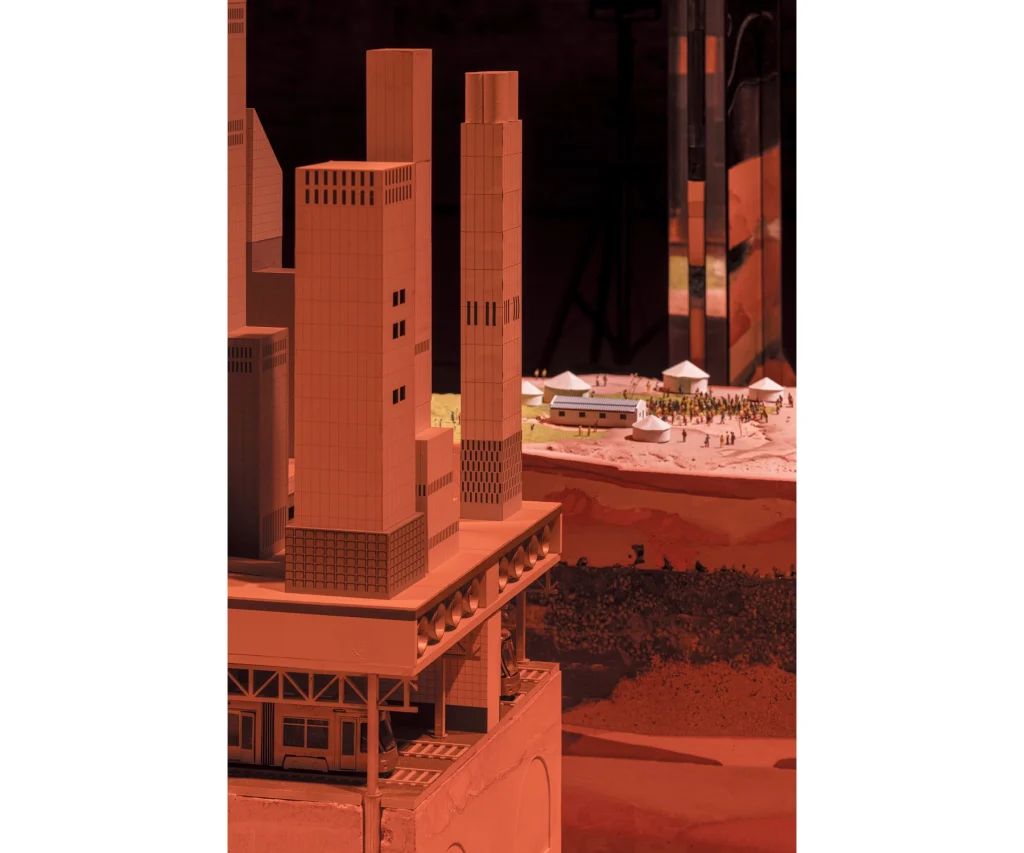Pratiksha Shome
Last week, as Canadian wildfire smoke dyed the air orange in New York City, architect Andrés Jaque saw an unsettling resemblance between the hazy sky and an installation he had just unveiled at the most recent Venice Design Biennale. The artwork displays a cityscape engulfed in a post-apocalyptic orange glow and is titled XHOLOBENI YARDS. Titanium and the Planetary Making of SHININESS / DUSTINESS. The link, which Jaque observed, however, went beyond this visual allusion and cut to the core of the project’s underlying message: that while design can help hide the effects of climate change, their reality cannot be avoided.
The inspiration for XHOLOBENI YARDS came to Jaque while he was strolling through Hudson Yards, a busy commercial district in New York City topped by The Vessel, a sizable, honeycomb-like assembly that is permanently closed due to a string of suicides that occurred there. Jaque did, however, remark how shiny it was—blindingly, impossible-to-shine.
Jaque found that a titanium-derived coating, which not only creates a reflective layer but also, astonishingly, draws pollutants from the air through a process called photocatalysis, which transforms harmful pollutants into harmless soluble nitrate salts that get washed from a building’s facade with rainfall, is what gives the vessel its shine. However, Jaque discovered pollution at the other end of his investigation into how such a titanium substance is made. Sand in Xolobeni, South Africa, is used to extract titanium; once the heavy metal has been removed, the sand turns volatile and light, essentially turning into dust. Jaque expressed it this way: “For Hudson Yards to be that shiny, Xolobeni needs to be dusty.”
As the ground itself lifts with the breeze and covers homes and crops, wends its way into people’s lungs, and damages the local economy, the extraction process has changed Xolobeni. The potential for a titanium mine at Xolobeni, operated by the Australian firm Mineral Commodities Ltd., has been made possible by the need for this metal. The Xolobeni people’s habitat, the terrain, would be destroyed by the mine. A major investor has divested from the mine as a result of increased violence against activists as a result of opposition to the project, however Mineral Commodities still has a significant share and is trying to find a solution. Jaque is especially intrigued by how wealthy cities that are home to the world’s elite try to protect themselves from pollution and climate change by utilising architecture that places the blame for the environmental crisis on others.
According to Jaque, “after 2008, individuals realised that buildings store money by creating locations where environmental toxicity and the climate problem could be ignored and transported elsewhere so the elite could escape the consequences of this disaster. What we’re witnessing is an unachievable endeavour to “secure” major cities like New York, London, and Hong Kong as sites for the remediation of environmental devastation.
The PlaNYC effort from the beginning of the 2010s, led by former Mayor Michael Bloomberg, is one instance of how this has played out in New York. The Clean Heat component of the programme aims to enhance New York City’s air quality by switching from heavy oils to natural gas for building heating. Sulphur dioxide levels in the city decreased by 69 percent, and soot pollution levels decreased by 23 percent as a result of the plan. But as an article for Tablet Mag demonstrated, a rise in the desire for ‘cleaner’ natural gas also meant a rise in the use of fracking, a famously filthy extraction technique that even Bloomberg himself opposed when proposals to frack in New York State were raised. Therefore, the fracking that powered New York was carried out in Pennsylvania, and under Bloomberg’s leadership, a pipeline connecting Pennsylvania to New York’s Meatpacking District was constructed.
“Seeing the exceptional quality in a city like New York, a place where there is so much pollution produced, gives the false impression that waste can be gotten rid of when it is really just relocated,” said Jaque. “Relocated,” that is, to areas with a disproportionately coloured population and little financial resources. In XHOLOBENI YARDS, a world in which New York is encircled by the pollution it causes elsewhere, whether it be in close-by Pennsylvania or far-off South Africa, is envisioned. Then the imagined situation really happened: pollution engulfed a metropolis built to make people feel secure from the types of upheaval that reliance on fossil fuels may bring about. Events like this enable us to “see [climate change], smell it, feel it in our landscapes, and feel it in all the violence that a significant portion of the world is already feeling,” according to Jaque. The current climate problem is not something that will occur in the future. It has already begun. Only in locations like New York, where power has accumulated, is it possible for it to go unnoticed.
Source: ARTnews





